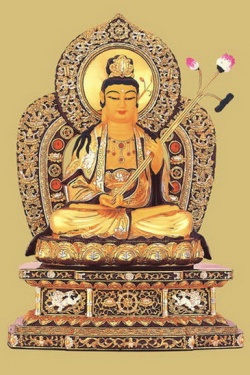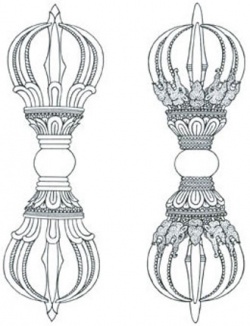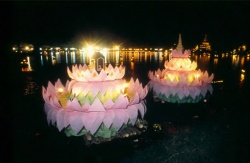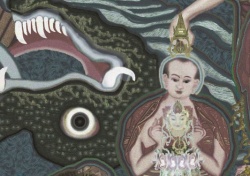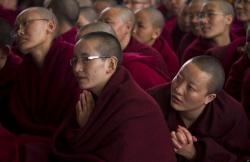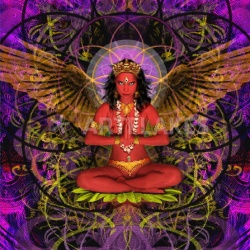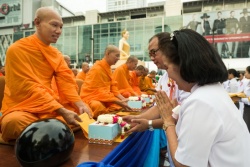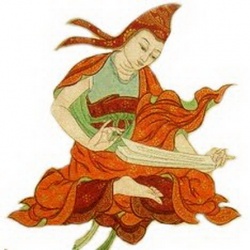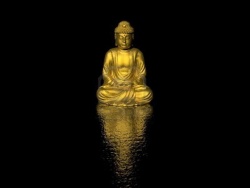Home: Religion / Buddhism Vasubandhu’s Abhidharmakosa lists six types of factors
by K. R. Paramahamsa
Delusion (moha) or Ignorance (avidyaa): Moha is one of the three bad roots that produce filthy awareness. It is always present in defiled mind. But it can be neutral like the other five in the category when it constitutes karmic retribution, as well as bad. It produces doubt and error. It is a residue in every feeling. It causes what is really frustrating, to be viewed as satisfying.
Delusion or moha is one of the six proclivities, but it is alone listed in this group, and the other five do not find place in this classification. However, some are found in the groups of Afflicting Factors and Neutral Factors.
Heedlessness (pramaada): Harivarman denies that heedlessness and heedfulness are separate factors.
• Sloth (kauseelya)
• Lack of Confidence (asrabdhi)
• Lethargy (styaana)
• Excitedness (auddhatya)
1. Factors that are Always Bad
• Shamelessness (ahreekya)
• Disregard (anapatraapya)
Both the factors concern one's acts and the results thereof.
2. Afflicting Factors (Upaklesa)
Vasubandhu lists ten factors in this category, while Harivarman lists eighteen. These factors breed karma by conditioning actions involving conceptual constructing, in everyone, even those on the path, up to the final stage of a noble person who has realized the truth of cessation. Such a one will have destroyed all afflictions and will not breed any more.
Vasubandhu's list runs thus.
• Anger (krodha)
• Hypocrisy (mraksa)
• Selfishness (maatsarya)
• Envy (eersyaa)
• Spite (pradaasa)
• Violence (vihimsaa)
• Vengefulness (upanaah)
• Deceit (maayaa)
• Craftiness (saathya)
• Arrogance (mada)
It does not mean that a perfected being is totally free of feelings. Neutrality (upeksa) is a feeling, as are compassion (karuna), friendship (maitri) and a kind of excitement (samvega). They are the feelings that a perfected being experiences.
3. Neutral Factors
Vasubandhu lists four factors in this category.
• Regret (kaukrtya)
• Sleepiness (middha)
• Initial Thought (vitarka)
• Sustained Thought (vicaara)
The tradition has it that the following are also to be considered as factors in this category.
• Attachment
• Repugnance
• Pride and
• Perplexity
4. Disassociated Fators
Contents of concomitant awareness are factors, which arise at the same moment as awareness (citta). They constitute conditioning factors associated with awareness (cittasamprayuktasamskaara). Vasubandhu identifies fourteen conditioning factors disassociated from awareness (cittaviprayuktasamskaara), so called as they are themselves no material factors or mental states complete with content. They are as follows.
Possession (praapti): Vasubandhu explains it as comprising either the occurrence (acquisition) for the first time of the experience of a factor, or the occurrence (accompaniment) of the experience of a type of factor in subsequent moments following the initial one. There is considerable literature as to the difference between acquisition and accompaniment.
Vasubandhu interprets the difference to relate to the difference between the first moment and the subsequent moments in the experience of a thing. It is to be borne in mind that, for Vasubandhu, a thing cannot persist through the periods of past, present and future. Samghabhadra, on the other hand, suggests that a factor can persist through past, present and future. He interprets ‘acquisition' as the first time in a person's experience that a factor has occurred, and ‘accompaniment' as describing the relation between that person's life stream and subsequent moment of the same sort.
The postulation of possession is intended to answer the difficult question of how the factors or events making up ‘my' stream are mine in distinction to those of ‘yours'. In fact, the factors related to ‘cessation' lie outside normal causal chains. They are part of the life stream of a particular person. The problem then is to account for the relation between these factors and the factors that constitute the stream we call the person undergoing these states. Further, it is crucial to tie the karmic traces, that is, the streams constituting such traces to the stream corresponding to the agent of the acts that laid down those traces. The factor of possession is postulated to accomplish all these tasks.
Non-possession (apraapti): When liberation approaches, the stream, which we call a person, enters various states of cessation, and loses the proclivities and other factors that occasion the breeding of karmic traces. As stated earlier, the severance of a given type of factors from a given stream comes about through a process called ‘revolution at the base'. Thereby, one acquires, as it were, counteragents (praptipaksa) to specific proclivities. The proclivities then cease to arise in that stream. In other words, they become separated from the stream of the rest of the factors comprising what we consider to be the person. Given that the ordinary causal process requires a factor to causally condition either another factor of the same or similar sort, or, at any rate, some factor or other, why and how can it happen at all? The factor of non-possession seeks to explain that separation.
Homogeneity (sabhaagataa): Why and how is it that those born on this earth comprise species whose bodies, organs, etc are so similar? If karma determines one's rebirth, and each person's karmic store is different from the next one's, why are not there as many different types of embodiments as there are streams of factors constituting what we take to be persons? To answer these questions, Buddhists posit the factor sabhaagataa, meaning ‘the character of having the same kinds of parts', herein called ‘homogeneity'. Vasubandhu refers to two kinds of homogeneity found in humans. One relates to the general homogeneity common to all living beings including humans, and the other relates to the human beings alone, distinguishing them from other living species.
Vasubandhu and Samghabhadra, in fact, defer over whether homogeneity is a real factor, or only a conceptual construction. Samghabhadra postulates that it is a real factor. He argues that if it were not so, we would not be able to classify people in the way we do. Vasubandhu, on the other hand, argues against its being a real factor. For him, homogeneity is actually nothing but being what one is. Not only living beings have parts of the same sort as others of the same species, but so do non-living things as well. Things, in general, fall into classes by virtue of their similarities and differences. Being homogenous is a general property of everything, not a specific property of anything.
• Non-ideation (aasamjnika)
• Non-ideation Trance (aasamjnisamaapatti)
• Cessation Trance (nirodhasamaapatti)
Buddhism has developed a fairly elaborate theory of advanced sorts of the cessation-trance-involved states where no ideas of any kind occur, and yet the meditator is alive and, in due course, returns from the trance to a life of sensations and thoughts. For example, in between death and beginning of the next life, there are no relevant mental and bodily factors which make thought possible. The moments in the stream corresponding to the ‘person' are devoid of content, and are as good as non-existent. Still the stream continues through such moments. How does this happen? This issue is precisely dealt with in the work Mahaavibhaasaa. Vasubandhu and Samghabhadra derive their views from this and similar works.
Sarvaastivaadins and Vaibhasikas on one hand, and the Daarstaantikas and Sautranikas on the other hold different views on this issue. Samghabhadra is with the Sarvaastivaadins and the Vaibhasikas. Vasubandhu is with the latter schools. Samghabhadra assumes that the above three factors are real and independent. He argues that they are required to explain why awareness of any kind, or mental concomitants, does not arise at all during trance. For him, the three factors do not constitute awareness, nor are they material entities. He, therefore, classifies them among the disassociated factors.
For Vasubandhu, on the other hand, it is the thought immediately preceding the first moment of non-ideation or cessation that causes such a moment to arise, and to produce a material location in the body for the trance state. In each successive moment, another similar empty location is caused to arise as long as the trance lasts. It is, therefore, not necessary to assume the existence of the three factors as independent meditative states. They simply are constructions, manners of speaking of the cessation of thought.
Vitality or Life-force (jeevita): Buddhism assumes that each ‘person' is merely a series of momentary factors. ‘What distinguishes a stream of factors constituting a ‘person' from a stream constituting, say, a chair, and, in particular, what keeps a person ‘alive' in the state of trance?' are moot questions. Even in the early Buddhist sutras, one finds reference to a controlling faculty made responsible for this peculiarity. Similarly, the faculties of masculinity and femininity are considered responsible for gender differentiation. In this context, the factor ‘vitality' finds its place in Vasubandhu's list of disassociated factors. It is, however, surprising that the factors of masculinity and femininity do not find their place in his list.
Both Vasubandhu and Samghabhadra discuss the problem of vitality in great detail. Cox makes a detailed comment on this issue.
‘There are three major issues in the later treatments of vitality; first, the possibility of states without thought - specifically, the state of non-conception and the two states of equipoise of non-conception and cessation - which would lack perceptual consciousness; second, the possibility of rebirth in the formless realm, which would lack warmth; and third, the discrimination of life from death within the stream of any given sentient being. Underlying these specific issues is a fundamental disagreement concerning the ontological status of vitality as a discrete factor. For Samghabhadra and the Sarvaastivaada-Vaibhasikas, the three factors of vitality, warmth, and perceptual consciousness are not in all cases inextricably linked; for if they were, states said to be without thought would have thought (that is, perceptual consciousness), and rebirth states in the formless realm would have form (that is, warmth). If life were distinguished from death only by the presence of perceptual consciousness, states without thought would be tantamount to death. Further, since beings in the formless realm lack a corporeal basis, and, therefore, warmth, were it not for vitality, must be admitted to exist as a discrete and real force capable of supporting both warmth and perceptual consciousness. What then would support vitality, especially given the fact that vitality remains when either warmth or perceptual consciousness is absent? Vitality is itself supported by previous action (karman) and homogeneous character (sabhaagataa) both of which are also, like vitality, characteristic only of sentient beings.'
Samghabhadra considers the three reasons stated by Cox sufficient to warrant postulation of vitality as a distinct and real dissociated factor. On the other hand, Vasubandhu does not consider it a real factor and states that vitality is only a conceptual construction.
He does not, however, advance any reasons for his postulation.
• Birth (jaati)
• Duration (sthiti)
• Ageing (jaraa)
• Termination (anityataa)
These four states characterize all conditioned factors, providing each factor the time to perform the function appropriate to it. Samghabhadra accepts these four as actual factors, while Vasubandhu disagrees.
• Collection of Words (naamakaaya)
• Collection of Phrases (padakaaya)
• Collection of Phonemes (vyanjanakaaya)
In Abhidharma analysis, the ‘phoneme' or syllable consists of a vowel alone, or a consonant, or a consonant-cluster plus a vowel. For example, the term ‘Abhidharma' consists of the phonemes a, bhi, dha and rma. These phonemes then form the basis of the word dharma or a phrase abhidharma.
Further, names, phrases, and phonemes constitute separate and real factors for the Sarvaastivaadins, and are classed among the dissociated factors, as they are related to material items as well as thought. But Vasubandhu defines a word as a collection of identifications (samjnaasamukti).
As in other cases, Vasubandhu and Samghabhadra differ in their interpretation of the three categories.
Samghabhadra considers language as involving factors of these three categories in relation to one another. On the other hand, Vasubandhu claims that the three categories are unnecessary. That what must be postulated is language alone. For him, a word is not a separate factor. Words and phrases are not collections of sounds indicating phonemes. Rather, it is speech that constitutes language. Samghabhadra disagrees and states that ‘language itself' cannot be identified with sound alone, internal thoughts of objects alone, or with what is conveyed in communication alone. Therefore, he classifies the components of language as dissociated factors.
5. Unconditioned Factors
There are three unconditioned (asamskrta) factors in Vasubandhu's list of seventy-five factors. They are
Empty space (aakaasa)
Calculated cessation (pratisamkhyaanirodha)
Uncalculated cessation (apratisamkhyaanirodha).
Vasubandhu's list of factors does not include such things as dependent origination, infinite space, consciousness, nothingness, and ‘neither-consciousness (identification)-nor-non-consciousness (non-identification)'. Vasubandhu has not considered them factors themselves, but rather types or ‘locales' of factors.
Unconditioned factors are eternal and non-contaminating. They do not produce karmic residues. According to Vasubandhu, they enter into causal series, though in a limited way. Though Vasubandhu lists the three unconditioned factors, they are, for him, actually entities of absence, and not real. Samghabhadra, however, disagrees with this postulation. He argues that calculated cessation, for instance, is an effect, though it has no effect. It can enter into meditation as a supporting object, and is acquired by practice of the noble path. Thus, it is not merely an absence.
As for the factors, empty space is a clear enough notion. One is, however, to distinguish the unconditioned space from the element space, which Samghabhadra takes to be a different actual factor.
Calculated cessation is, in fact, liberation, nirvana, the cessation of all factors, arrived at, through the intentional attainment of, the stage by a perfected being. Uncalculated cessation refers to the cessation of a type of factor when the necessary condition for its production is cut off, for all future. For example, if one meets premature death, those factors, which would have conditioned the remainder of one's life's experiences, are unable to arise. This inability is termed uncalculated cessation. As one proceeds along the path rooting out proclivities, the factors, which would have instantiated those proclivities in future lives, undergo this ‘uncalculated cessation'.
6. Other Sets of Factors
There are a few sets of other factors.
Four Immaterial States (brahmavihaara): These are stated to be friendship, compassion, sympathy and equanimity. These are also referred to as ‘boundless' states of ‘unlimited scope'.
Four Knots (grantha) or Floods (ogha) or Bonds (yoga): In Dhammasangani, the same list is called by all the three names. The list includes ignorance, covetousness, malice and addiction to moral precepts and vows. However, in the Sangeetiparyaaya, a different list appears as the four floods. The list consists of sensual pleasure, existence, wrong views and ignorance.
Four Discriminations (pratisamvid): In the Vibhanga, these comprise discrimination as to the results of one's actions, as to factors, as to the appropriate choice of words and as to one's awareness of others. But in Sangeetiparyaaya, the four concern factors, consequence, awareness of others and convention. The Patisambhidaamagga has another list of four discriminations. They are things (or meanings) (artha), factors, language (nirukti) and perspicacious-ness (pratibhaana).
Five or six Hindrances (neevarana): Dharmasamgraha lists them as sexual interest, malice, stolidity and torpor, distraction and worry, perplexity and ignorance. There are only five of these listed in Sangeetiparyaaya - ignorance is not counted there as a hindrance.
Fetters (samyojana): Different texts list different numbers of these, and one finds different numbers listed under this rubric in different places in the same text. For example, at Dhammasangani III.1.1.8, there are three fetters - belief that the body is real; perplexity about the master, the dharma, the order; and addiction to moral precepts and vows. But at III.1.2.4, the fetters number ten, the earlier three being joined by passionate desire, repulsiveness, pride, passion to be reborn, envy, meanness, and ignorance. Subsequent lists in Vibhanga, Sangeetiparyaaya and elsewhere overlap these, not always numbering ten.
The above lists are not intended as in any way definitive of anything, but merely suggest that, despite the apparent repetitiveness of these texts, the actual content is different with each new author.

